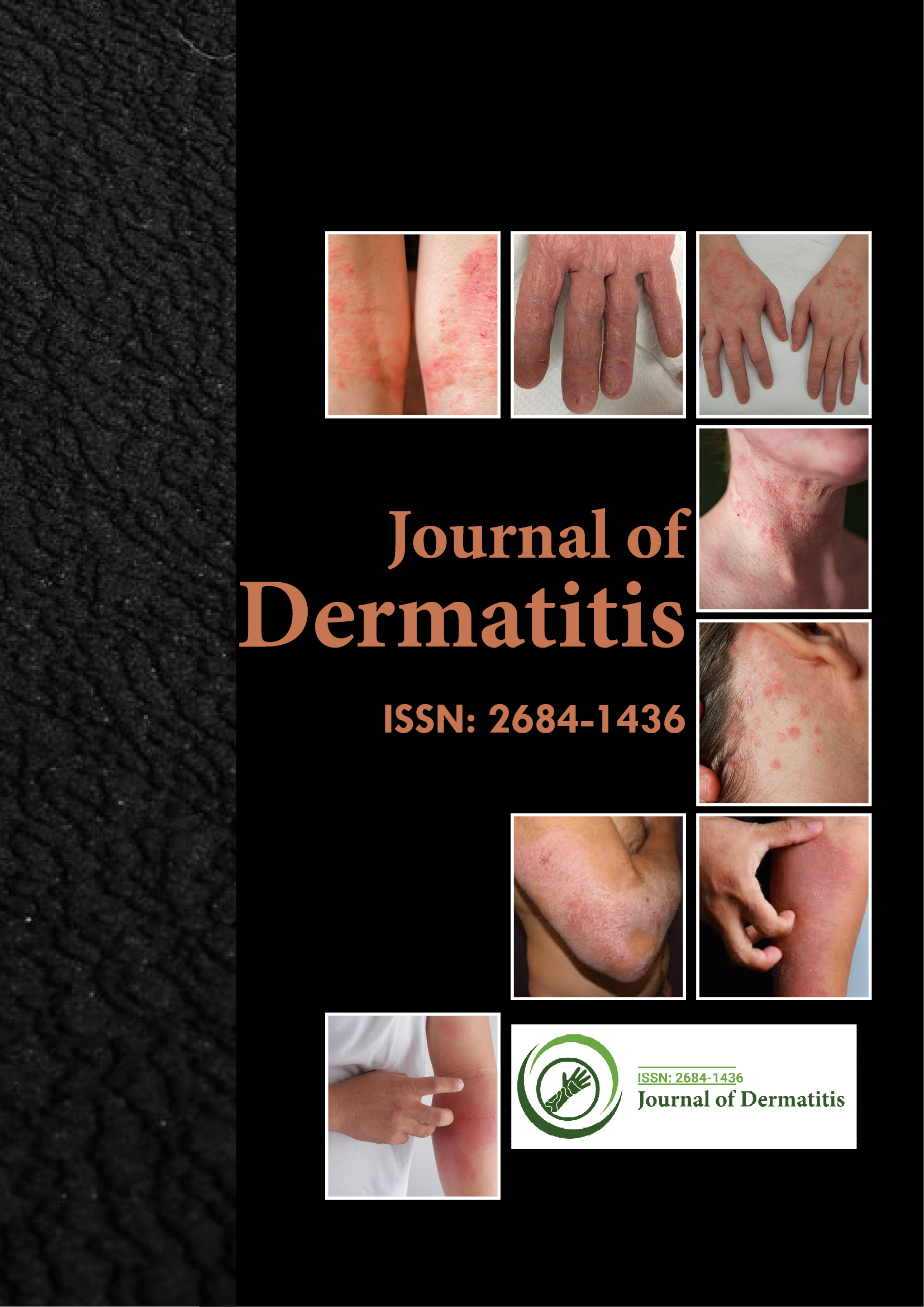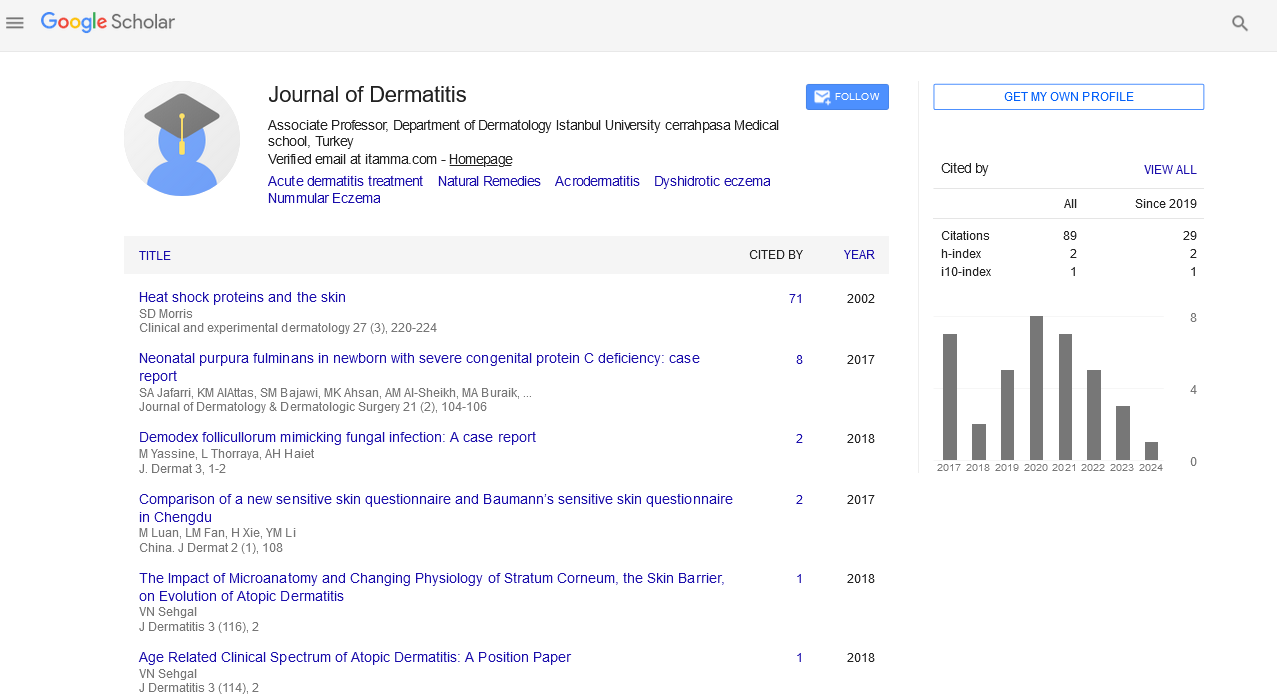Indexed In
- RefSeek
- Hamdard University
- EBSCO A-Z
- Euro Pub
- Google Scholar
Useful Links
Share This Page
Journal Flyer

Open Access Journals
- Agri and Aquaculture
- Biochemistry
- Bioinformatics & Systems Biology
- Business & Management
- Chemistry
- Clinical Sciences
- Engineering
- Food & Nutrition
- General Science
- Genetics & Molecular Biology
- Immunology & Microbiology
- Medical Sciences
- Neuroscience & Psychology
- Nursing & Health Care
- Pharmaceutical Sciences
Commentary - (2024) Volume 9, Issue 1
Erythrodermic Psoriasis: A Severe Skin Condition
Yaside Josh*Received: 02-Mar-2024, Manuscript No. JOD-24-26013; Editor assigned: 05-Mar-2024, Pre QC No. JOD-24-26013 (PQ); Reviewed: 21-Mar-2024, QC No. JOD-24-26013; Revised: 27-Mar-2024, Manuscript No. JOD-24-26013 (R); Published: 05-Apr-2024, DOI: 10.35248/2684-1436.24.9.230
Description
Large areas of the body are covered with scaling and a widespread, burning redness that characterize erythrodermic psoriasis, an uncommon and severe form of psoriasis. In contrast to the isolated patches that characterize conventional plaque psoriasis, erythrodermic psoriasis can mimic severe burns, resulting in excruciating discomfort and itching. The body's capacity to control temperature and fluid balance is compromised by this illness, which increases the risk of consequences like edema, hypothermia, and dehydration.
Erythrodermic psoriasis can be brought on by allergic reactions, infections, intense sunburns, stress, and abrupt discontinuation of systemic psoriasis therapies. This type of psoriasis has to be treated medically right away since it can lead to life-threatening conditions like sepsis, pneumonia, and heart failure. Strict adherence to recommended therapies, such as topical medications and immunosuppressants, is necessary for effective care. Even though erythrodermic psoriasis is a chronic condition that is currently incurable, patients' quality of life can be greatly enhanced by careful disease management, which can greatly lower the frequency of flare-ups and the consequences they can cause.
A rare skin disorder called erythrodermic psoriasis results in a crimson rash that covers much of the body. Similar to a burn, the rash can be just as fatal because it can produce chills, fever, and dehydration. Erythrodermic psoriasis requires immediate medical attention.
Psoriasis is a persistent skin illness that arises when the body creates new skin cells faster than they shed or die. As a result, cells build up on the skin's surface. Patches of thick, itchy skin covered in scales that are pink, red, or white might occur. This condition, also called plaque psoriasis, is not harmful to their health, despite the fact that it may be unsightly.
Despite being a rare form of the illness, erythrodermic psoriasis is significantly more severe than the majority of other subtypes. Plaques have the potential to almost entirely cover the body, with potentially fatal implications. Psoriasis affects an estimated 3% of Americans, most of whom are adults. As many as nine out of ten psoriasis sufferers have plaque psoriasis. Only about 3% of those with psoriasis have the erythrodermic form of the disease. Approximately one in three people who develop erythrodermic psoriasis also have plaque psoriasis. It happens when their immune system mistakenly overreacts, causing harm the body. Inflammation caused by this response hastens the production of new skin cells.
People with poorly controlled plaque psoriasis are most at risk of developing erythrodermic psoriasis. If psoriasis treatments, such as immunosuppressants or corticosteroids, are stopped suddenly, erythrodermic psoriasis may result. Excessive use of medications such as topical steroids and retinoids, which are related to vitamin A, can also cause symptoms. Erythrodermic psoriasis can occur in certain individuals as a result of drug allergies, infections, severe sunburns, stress, or substance abuse disorders.
Erythrodermic psoriasis can appear rapidly in a few days (as an acute rash). The usual scenario for plaque development is an extant psoriasis rash. It could take many months for erythrodermic psoriasis to fully manifest. They have redness and inflammation on over 90% of their body, which mimics a serious burn or sunburn. The skin rash may feel burning and is quite irritating. In addition, skin in large sheets may begin to flake off. For some people, losing their nails and toenails might be problematic.
Erythrodermic psoriasis symptoms might appear and disappear. The rash and other symptoms may be minor or nonexistent as a result of treatments that control the illness and even put it into remission. Still, flare-ups may occur, reviving the broad rash and associated symptoms. High levels of itching or pain on the skin are possible signs of erythrodermic psoriasis. The rash affects the body's ability to perspire and regulate body temperature. The patient may have low body temperature, or hypothermia. It could lead to dehydration and affect electrolyte levels. Possible adverse effects include fever, chills, and edema (fluid retention) in the ankles and feet. While they are rare, infections can occur on occasion. The illness raises their chance of developing potentially fatal conditions such as heart failure, pneumonia, and infections like septicemia, which can result in sepsis.
Citation: Josh Y (2024) Erythrodermic Psoriasis: A Severe Skin Condition. J Dermatitis. 9:230.
Copyright: © 2024 Josh Y. This is an open-access article distributed under the terms of the Creative Commons Attribution License, which permits unrestricted use, distribution, and reproduction in any medium, provided the original author and source are credited.

